PAUL SIMONS TOP 25 Page 2
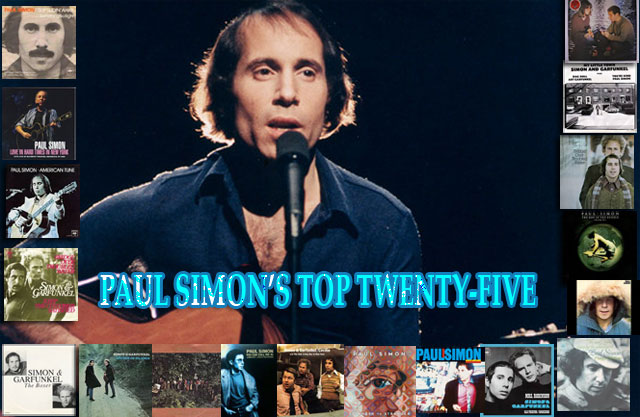
(11) “Late in the Evening”
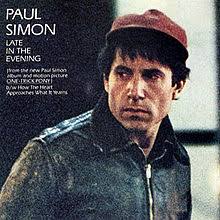 I decided to include this song after I had finalized my selections—as a matter of fact, I had 33 songs that I’d already done full write-ups on and knew I would have to eliminate some. After all, 25 is 25—a self-imposed limit, but a limit nonetheless. But the reason I ultimately chose “Late in the Evening” was because, the longer I worked on the list, the more it kept coming into my head. More importantly, it was Paul Simon’s love song to music, and epitomized what music has meant to him throughout his life. It was introduced in the film, “One Trick Pony,” in which Simon starred and wrote the music and has been an essential part of his repertoire ever since. (To make room for this song, I had to drop the wonderful “Kodachrome,” which remains a classic pop song, and one far more successful than “Late in the Evening.”)
I decided to include this song after I had finalized my selections—as a matter of fact, I had 33 songs that I’d already done full write-ups on and knew I would have to eliminate some. After all, 25 is 25—a self-imposed limit, but a limit nonetheless. But the reason I ultimately chose “Late in the Evening” was because, the longer I worked on the list, the more it kept coming into my head. More importantly, it was Paul Simon’s love song to music, and epitomized what music has meant to him throughout his life. It was introduced in the film, “One Trick Pony,” in which Simon starred and wrote the music and has been an essential part of his repertoire ever since. (To make room for this song, I had to drop the wonderful “Kodachrome,” which remains a classic pop song, and one far more successful than “Late in the Evening.”)
But this song acknowledges the power of music, and the role it has played in his life, and that, for me, made it hard for me to leave off this list.
It is a joyous celebration of Simon’s two loves—music and romantic love. In the first stanza, you can hear the influence of sounds coming from his mother’s radio as they seep into his room—and stamp themselves upon his sub-conscious. The second stanza conjures up urban images of doo-wop sounds from the street and handing out with your pals with the girls sitting on the stoops. It’s a real teen-age image from the mid-50’s, and easy to relate to whether you were “born at the right time” and lucky to have been a part of the birth of rock n’ roll, or not. By the third stanza, he is a performer, and with the aid of a little mood modifier, returns with his funky guitar, turns up the amp (perhaps to “11”) and “blows the room away.” Just like the hero reminiscing in “Duncan,” (see song #16, below) our hero is one with his talent and, no doubt, thanking the Lord for his fingers as well. In the concluding stanza, Simon salutes the romantic love he feels for a special (and unidentified) woman. This love has the power of music—and then some. If you love rock music—and love Paul Simon, you’ve got to love this song.
Best performance: “Simon & Garfunkel Live at Central Park, 1981.” Though not originally an S&G song, you see how great can become greater when the two combine in harmony.
(“One Trick Pony,” 8/12/80, Warner Brothers)
(12) “Mother and Child Reunion”
 Like the light-hearted “Me and Julio Down by the Schoolyard,” this more serious song is a mystery as well. We don’t know what has happened to have brought about such a “strange and mournful day.” Simon has said that it was occasioned by the death of his dog, and he was dealing—for the first time—with a personal loss, and imagining it extending beyond a dog. Apparently, the enigmatic title comes from the name of a dish in a Chinese restaurant, and I have seen it on some menus, but always assumed the song came first. In any event, I took it literally enough to think it was referring to either the loss (or separation) of a mother from her child, and the hoped-for reunion to come. It was Simon’s first experimentation with a Reggae rhythm, and he used Jimmy Cliff’s band as the sidemen—can’t get more Reggae than that!
Like the light-hearted “Me and Julio Down by the Schoolyard,” this more serious song is a mystery as well. We don’t know what has happened to have brought about such a “strange and mournful day.” Simon has said that it was occasioned by the death of his dog, and he was dealing—for the first time—with a personal loss, and imagining it extending beyond a dog. Apparently, the enigmatic title comes from the name of a dish in a Chinese restaurant, and I have seen it on some menus, but always assumed the song came first. In any event, I took it literally enough to think it was referring to either the loss (or separation) of a mother from her child, and the hoped-for reunion to come. It was Simon’s first experimentation with a Reggae rhythm, and he used Jimmy Cliff’s band as the sidemen—can’t get more Reggae than that!
The song starts right out answering the mourner “No, I would not give you false hopes,” but, be patient, for “the mother and child reunion is only a motion (moment) away.” It’s an interesting turn of lyrical phrase, because it sounds as if he’s saying that it’s only an “emotion” away, suggesting that, perhaps, wishing can make it so. That’s just my take, but see what you think.
Despite the advice to “let it be,”(a Beatles’ reference) the mourner can’t, because “he’s never been laid so low,” and realizes that this is not an isolated occurrence—loss will recur “over and over again, in the course of a lifetime run.” And though it does, while we learn that loss is a part of life, we still yearn for that reunion, be it here or in a better place. The song has a beautiful melody, a strong lyric with a message, and an introduction to a new rhythm to which Simon would return.
(“Paul Simon,” 1/24/72 Columbia)
(13) “Hearts and Bones”
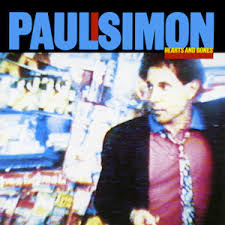 The title song of one Simon’s most personal—and underrated—albums, it tells of Simon’s relationship with the woman who was soon to become his wife, the late Carrie Fisher. If you didn’t know better (and I, for one, didn’t), you’d think this song was writtenafter they were married, perhaps, even, on the brink of divorce. Actually, it was written at a point in time when they had retired to their respective coasts (east and west) to think things through before finally beginning a marriage that was only to last eleven months. The images describing their relationship are literally electric (e.g …She burned like a bride…love like lightning, shaking till it moans.”) In it, he sings of “the arc of a love affair, his hands running down her hair, waiting to be restored.” The hearts part is obvious, the bones part less so. At the beginning of their relationship, Simon describes the very fact of their (upcoming) marriage being “outrageous, the bride contagious.” Simon, in marrying Carrie Fisher, a movie star who was herself marrying one of America’s most well-known pop singers (Simon), was replicating her mother, Debbie Reynolds’s marriage to teen idol, Eddie Fisher, a man, like Simon, with multiple gold records to his name.* At the song’s conclusion, the reference to hearts and bones becomes clear: “You take two bodies and you twirl them into one. Their hearts and their bones. And they won’t come undone. “ Anyone ever involved in a long-term relationship knows the truth of those words. Many of us pay quite a price for ignoring that fact.
The title song of one Simon’s most personal—and underrated—albums, it tells of Simon’s relationship with the woman who was soon to become his wife, the late Carrie Fisher. If you didn’t know better (and I, for one, didn’t), you’d think this song was writtenafter they were married, perhaps, even, on the brink of divorce. Actually, it was written at a point in time when they had retired to their respective coasts (east and west) to think things through before finally beginning a marriage that was only to last eleven months. The images describing their relationship are literally electric (e.g …She burned like a bride…love like lightning, shaking till it moans.”) In it, he sings of “the arc of a love affair, his hands running down her hair, waiting to be restored.” The hearts part is obvious, the bones part less so. At the beginning of their relationship, Simon describes the very fact of their (upcoming) marriage being “outrageous, the bride contagious.” Simon, in marrying Carrie Fisher, a movie star who was herself marrying one of America’s most well-known pop singers (Simon), was replicating her mother, Debbie Reynolds’s marriage to teen idol, Eddie Fisher, a man, like Simon, with multiple gold records to his name.* At the song’s conclusion, the reference to hearts and bones becomes clear: “You take two bodies and you twirl them into one. Their hearts and their bones. And they won’t come undone. “ Anyone ever involved in a long-term relationship knows the truth of those words. Many of us pay quite a price for ignoring that fact.
The recent death of Carrie Fisher makes this complex song all the more poignant. The song is a true accounting, a recollection of a trip the two took together somewhere along the arc of their relationship. Unlike “The Dangling Conversation,” (not included on this list) this is a volatile relationship, and one never giving over to going through the motions with each other and mouthing empty platitudes.
I don’t think any line in English literature has ever contained the phrase, “one and one half wandering Jews.” Interesting how this line contrasts with the couple’s travels in the Sangre de Christo (“Blood of Christ”) mountains of New Mexico, distinctly Christian imagery. Are hearts and bones the relics of the couple’s past or the glue which will bind their future? Maybe both, because, as pointed out above, their hearts and bones won’t come undone. Is it love, or is heredity the immutable thing that makes us who we are in spite of ourselves? No wonder love and life are so difficult.
(Paul Simon, Hearts & Bones, 11/4/83, Warner Brothers)
*(If anything, Eddie Fisher and Debbie Reynolds were bigger stars in their day than Paul and Carrie, but that might just be my age speaking.)
(14) “The Late Great Johnny Ace”
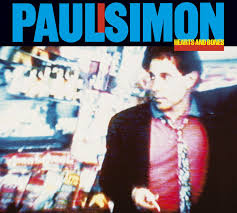 In 1981, S&G had their marvelous reunion concert in the park. In it, Simon introduced this reminiscence about a relatively minor singer from the early days of rock n’ roll.* He apparently got the title from hearing a radio ad for a greatest hits recording by “the late, great Johnny Ace.” In the song, Simon recalls hearing of Ace’s death in 1954, and admits not being such a big fan, but nonetheless sending away for a memorial photograph “inscribed” with the song’s title. Simon uses Ace’s death as a metaphor for much of what followed musically, from the time of the Beatles and the Rolling Stone’s when rock music had taken on an immediacy and importance like no time in its history and, as Simon says, the music was “blowing my way.” The song then skips forward to a cold December night some years later, when a stranger walks up to him and asks if he’d heard John Lennon had died. They then repair to a bar where they drink and play music until closing time, and every song they played that night was to (but not by) the late, great, Johnny Ace. Ace’s death, though both sad and tragic was—as mentioned above—that of a rock n’ roll footnote, virtually forgotten until Simon’s song revived his memory. Unfortunately for Simon’s debut performance of it, a fan stormed the stage near the end of the song, barked some message to Simon, and ruined the song’s ending.
In 1981, S&G had their marvelous reunion concert in the park. In it, Simon introduced this reminiscence about a relatively minor singer from the early days of rock n’ roll.* He apparently got the title from hearing a radio ad for a greatest hits recording by “the late, great Johnny Ace.” In the song, Simon recalls hearing of Ace’s death in 1954, and admits not being such a big fan, but nonetheless sending away for a memorial photograph “inscribed” with the song’s title. Simon uses Ace’s death as a metaphor for much of what followed musically, from the time of the Beatles and the Rolling Stone’s when rock music had taken on an immediacy and importance like no time in its history and, as Simon says, the music was “blowing my way.” The song then skips forward to a cold December night some years later, when a stranger walks up to him and asks if he’d heard John Lennon had died. They then repair to a bar where they drink and play music until closing time, and every song they played that night was to (but not by) the late, great, Johnny Ace. Ace’s death, though both sad and tragic was—as mentioned above—that of a rock n’ roll footnote, virtually forgotten until Simon’s song revived his memory. Unfortunately for Simon’s debut performance of it, a fan stormed the stage near the end of the song, barked some message to Simon, and ruined the song’s ending.
Perhaps the song is meant to remind us that every such death (both Ace and Lennon died of gun violence) is tragic, whether a minor (Ace) or major (Lennon) figure. In any event, this song is a tribute to every performer (great and small) who died before his (or her) time.**
*“Pledging My Love,” Ace’s only number 1 song, was released posthumously, following what was either an accident with a hand-gun possibly playing “Russian Roulette, or a suicide..”
**Unspoken, of course, are the more familiar deaths of Buddy Holly, Ritchie Valens, and J. P. Richardson (“The Big Bopper”), but it is hard not to think of them as well when listening to this song. Fortunately, they had a pretty good song (LOL!) to memorialize them in Don McLean’s classic “American Pie.” While “Johnny Ace” didn’t make the S&G reunion album, a spare, and haunting version appears on “Hearts and Bones.”
(15) “Rene and Georgette Magritte (with their dog after the war)”
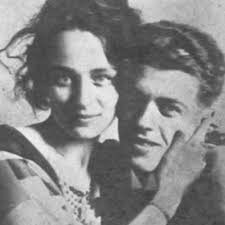 In his Playboy Interview with Tony Schwartz from 1984, Simon was saying that he decided to write the song after seeing a photo of the artist walking with his wife and dog, (and the photo’s caption was the song’s title). Schwartz jokingly said, “Such an obvious title after all.” Simon, equally jokingly, replied, “that’s right, leaped on it before it could be spotted by my contemporaries.”
In his Playboy Interview with Tony Schwartz from 1984, Simon was saying that he decided to write the song after seeing a photo of the artist walking with his wife and dog, (and the photo’s caption was the song’s title). Schwartz jokingly said, “Such an obvious title after all.” Simon, equally jokingly, replied, “that’s right, leaped on it before it could be spotted by my contemporaries.”
Simon, as mentioned in my introduction to this piece (and something he confirms in the Playboy interview), is a rock and roller at heart. It was in his bones at the beginning of his career as a recording artist, and he remains in its debt. This is a clever song, with a lovely melody and great counter-melody, provided softly in the background by an old rock n’ roll group, The Harptones, evoking images of the old songs that (Simon tells us) so captivated the artist and his wife (and perhaps the dog as well). While it is (I suspect) intentionally hard for us to make out the words sung by the Harptones, one can discern the fragmentary “in the still of the…” a reference to the marvelous “In the Still of the Night,” by the Five Satins, one of the groups whose recordings Renee and Georgette so treasured.
In the release, Simon talks of the couple falling asleep, and discovering that “all their personal belonging had intertwined,” just it did for the two lovers in “Hearts and Bones” earlier on the same album. In the process of writing the song, Simon has a lot of fun (as do we) in imagining Renee and Georgette Magritte’s walk.* Simon paints a portrait of the couple (Magritte was Belgian by birth) strolling the streets of post-WWII New York City. When they get home, Simon evokes nursery rhyme memories as the couple is described as “easily losing their evening clothes, they danced by the light of the moon,” to the Penguins, the Moonglows, the Orioles and the Five Satins, all early “doo wop” groups. This theme continues through the song as mannequins dressed in style in a Greenwich Village men’s store “bring tears to their immigrant eyes,” just like listening to the old singing groups.
In the final stanza, Simon talks about the couple “dining with the power elite,” an ironic reference to a mid-century non-fiction book by C. Wright Mills about what would now be called the “one per-centers.” Magritte, a communist sympathizer, was unlikely to keep such capitalist company, although the rich were doubtless purchasers of his paintings, now priceless (and doubtless now included in the collections of the millionaires and billionaires he refers to in the “Boy in the Bubble,” see #21 below). In the final stanza, the couple discovers, in their bedroom drawer, hidden away “in the cabinet cold of their hearts,”** recordings of the old rock n’ roll groups. This time, Simon, goes to a minor chord each time he recites the names of the groups, as if to salute something long gone, if not truly for the Magritte’s (who I doubt were acquainted with the early rhythm & blues groups), certainly for Simon, as they were the heroes of his youth. (“Hearts and Bones”)
* Magritte, by the way was a remarkably distinctive artist, whose originality and imagination is matched by few. Magritte, by the way was a remarkably distinctive artist, whose originality and imagination is matched by few. There are few words that are more over-used than “surreal,” but Magritte was the real “surreal” deal. His “Phases of the Moon” paintings are simply astonishing, as is this spare, beautiful song with words to match the haunting, nostalgic tone of its melody.
**I thought “cabinet cold of their hearts” was an evocative image, but not sure what it meant. I looked it up on the Web, and found a description of “cold cabinets.” I have no way of knowing if Simon thought of this in using the expression, but it refers to a “refrigeration pump built to last…pumps away defrost water and filters debris.” The idea of something built to last that would keep the storage unit clean of things that might corrode it and keep things like treasured recordings preserved is a bit of a stretch (even for me), but there you have it. In any event, it’s a turn of phrase that resonates.
(16) “Duncan”
This evocative story song tells of a young man with the quintessentially “American” name of Lincoln Duncan, and his journey from youth into manhood. It is, as our English professors told us, picaresque, as we follow him through both travels and travails. Musically, “Duncan” is a first cousin to “The Boxer,” both in the tempo of the fingerpicking guitar technique each employs as well as the break between stanzas. (It also is similar musically to “El Condor Pasa,” in its between stanza’s “break.”) Although both songs tell stories, “Duncan’s” tale is a more straightforward one with none of the closing mystery of how and why a boxer suddenly appears in the seldom told tale of a poor boy.
Duncan’s story is a simple rite of passage, taking him from his present in a cheap motel room where the thin walls betray another couple’s marathon of sex, to a reminiscence on his own coming of age. The lyrics to this song are a model of simplicity; no esoteric symbolism, no abstruse references. Duncan is a son of a fisherman (and the fisherman’s friend) and in but one of the song’s clever internal rhymes, when Duncan reaches his prime, he describes having “left my home in the maritimes, and headed down the turnpike to New England.” Following a few hard times, he meets the young girl who (later that night ) makes a man out of him. He encounters her, “preaching sacred songs and reading from the Bible,” and tells her “I was lost, and she told me all about the Pentecost and I saw this girl was the road to my survival.” As indeed she proved to be. The song ends with our hero reminiscing on that night with respect to which his “memory lingers. I was playing my guitar underneath the stars, thanking the Lord for my fingers.” What guitar-picker could ask for more?
(“Paul Simon” 1/24/72 Columbia)
(17) “American Tune”
In the Weaver’s classic concert album, “The Weavers at Carnegie Hall,” there is a marvelous folk medley entitled “Around the World.” It begins with a melody by Hans Leo Hassler (yeah, him) with words by old folkie, Tom Glazer.* Hassler’s melody was adopted by Bach, and subsequently adapted (with minor modifications) by Simon. Regardless, it is a splendid melody. Written at the time of America’s bi-centennial, “American Tune” expressed the uncertainty and doubt many felt at what otherwise should have been a time of great celebration. The war in Vietnam had recently ended in an embarrassing evacuation and defeat, and the impeachment and resignation in disgrace of President Nixon were definers of much of the nation’s mood. Simon’s lyrics bring this out—“And I don’t know a soul who’s not been battered, don’t know a friend who feels at ease, I don’t know a dream that’s not been shattered and driven to its knees.” Later in the song, in words that would have been just as apt if they had been written today, he describes a dream in which he is dying and flying high above the clouds, and sees the Statue of Liberty sailing away to sea. In the next, and most powerful stanza, Simon evokes both history and potential that remains the American Dream. “We come on the ship they call the Mayflower, we come on the ship that sailed the moon, we come in the age’s most uncertain hour, and sing an American tune.” And few can sing (or write) an American tune better than Paul Simon.
Listen to the syncopation in the word “Mayflower,’ (with the emphasis on “flower”) as it precedes the downbeat. As the song closes, Simon reminds us that, although we can’t be forever blessed, he (reminiscent of Scarlett O’Hara) tells us that tomorrow’’s still going to be another (working) day, and he’s trying to get some rest. That’s another wonderful thing about Americans. We survive by keeping at it. I think Bach (and Hassler before him) would have been proud to have such a lyric accompany their music. As with Dylan’s “Chimes of Freedom,” ** “American Tune” is one for the ages.
“There Goes Rhymin’ Simon” (a silly title for a marvelous album). Honorable mention for the song: S&G’s reunion concerts, Willie Nelson, and the late Eva Cassidy.
*”Because All Men are Brothers ”and “American Tune” are both derived from Hassler’s “Mein G’mit is mir verwirret,” and appropriated by Bach in his more familiar “St. Matthew’s Passion.”
**Dylan’s “Chimes of Freedom,” by the way, is also an adapted melody. one Dylan took from “Chimes of Trinity,” a song the late Dave Van Ronk learned from his grandmother and passed on to Dylan
(See “The Mayor of MacDougal Street,” by Dave Van Ronk and Elijah Wald).
(18) “The Obvious Child”
This is a remarkable song, not just for its insights and allegories, but for its arrangement. It begins, unusually enough, with a drum solo, almost the kind that would precede a military march, celebrating a victory. But the victory (such as it is) being celebrated by this song is the endurance of two generations of Everymen; a father and a son who grows up and is himself relying on memories and the signs of advancing age. Is this the same son who Paul Simon once lulled to sleep with lines about his famous father in“St. Judy’s Comet”? Hardly.
Sonny, despite his father’s claims that he grows sunnier day by day, has no life of ease. The aging Sonny is himself leafing through his high school yearbook, remembering the days when he had a full head of hair and didn’t have to worry about monthly bills.
The father, who had a lot of fun and made a lot of money in his day, now struggles through sleepless nights. That said, as he looks up in the sky, there is something beyond the material that both he and this song glimpse; while some people say the sky is just the sky, he realizes that it is about another father and son—especially the son. Why deny the obvious child?
The reference to the cross is being in the ballpark is meant to remind us of a long-ago visit to New York’s Yankee Stadium by a long-dead Pope. But thi
Stereo Times Masthead
Publisher/Founder
Clement Perry
Editor
Dave Thomas
Senior Editors
Frank Alles, Mike Girardi, Russell Lichter, Terry London, Moreno Mitchell, Paul Szabady, Bill Wells, Mike Wright, and Stephen Yan,
Current Contributors
David Abramson, Tim Barrall, Dave Allison, Ron Cook, Lewis Dardick, John Hoffman, Dan Secula, Don Shaulis, Greg Simmons, Eric Teh, Greg Voth, Richard Willie, Ed Van Winkle, Rob Dockery, Richard Doran, and Daveed Turek
Site Management Clement Perry
Ad Designer: Martin Perry





Be the first to comment on: PAUL SIMONS TOP 25 Page 2